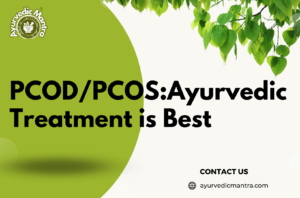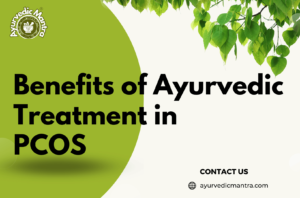
PCOD/PCOS: Ayurvedic Treatment is Best
Introduction Polycystic Ovary Disorder (PCOD) or Polycystic Ovary Syndrome (PCOS) is a common endocrine disorder affecting millions of women worldwide. It leads to hormonal imbalances,

The intricate interplay between our body’s systems often surprises us with unexpected connections in health and wellness. One such fascinating correlation exists between thyroid health and the eyes. Thyroid Eye Disease (TED), also known as Graves ophthalmopathy, is a condition that exemplifies this relationship. This article delves into the depths of Thyroid Eye Disease, exploring its causes, symptoms, diagnosis, and available treatment options. Let’s journey to comprehend how our eyes can provide crucial insights into our thyroid status.
Thyroid Eye Disease is an autoimmune disorder closely linked to an overactive thyroid gland known as hyperthyroidism. This ailment occurs when the immune system erroneously attacks the tissues surrounding the eyes. Although its exact cause remains elusive, it’s believed that an immune response triggered by the thyroid gland leads to the inflammation of eye tissues.
The symptoms of Thyroid Eye Disease can vary in intensity and presentation, making it a complex condition to diagnose. Individuals with TED may experience bulging eyes, redness, excessive tearing, and a feeling of grittiness or irritation. Additionally, some might encounter double vision, light sensitivity, and even difficulty closing their eyelids. These symptoms not only affect one’s physical well-being but also considerably impact self-esteem and emotional health.
Recognizing and diagnosing Thyroid Eye Disease is a multidimensional process that involves medical history assessment, clinical evaluation, and often, a battery of specialized tests. Ophthalmologists and endocrinologists collaborate to analyze the patient’s symptoms, measure eye protrusion, assess eye movement, and conduct imaging studies like CT scans or MRIs to visualize any changes to the eye tissues. This comprehensive approach ensures an accurate diagnosis and facilitates timely intervention.
To comprehend the connection between thyroid health and TED, we must first grasp the role of the thyroid gland. The thyroid gland in the neck orchestrates various bodily functions by producing hormones that regulate metabolism. An imbalance in thyroid hormone levels can set off a chain reaction, potentially leading to TED. The shared antigens between the thyroid and eye tissues further contribute to the development of this condition.
When it comes to managing Thyroid Eye Disease, a range of treatment avenues are available, tailored to the severity of the condition. Mild cases require minimal intervention, including lubricating eye drops, sunglasses to alleviate light sensitivity, and prisms to address double vision. More severe instances could demand immunosuppressive therapies or surgical procedures to correct misaligned eyes or relieve pressure on the optic nerve.
Coping with Thyroid Eye Disease extends beyond medical treatment. Emotional support, lifestyle modifications, and coping strategies are pivotal in enhancing one’s quality of life. Connecting with support groups, practicing stress-reducing techniques, and prioritizing overall well-being can provide the much-needed resilience to navigate the challenges posed by TED.
While complete prevention of Thyroid Eye Disease might not be guaranteed, managing underlying thyroid conditions can significantly reduce the risk. Regular thyroid function tests, early detection of hyperthyroidism, and prompt medical intervention can minimize the chances of developing TED.
In the intricate tapestry of human health, Thyroid Eye Disease serves as a poignant reminder of the interconnectedness of our bodily systems. The eyes often hailed as windows to the soul, can also serve as reflective mirrors, offering insights into our thyroid status. As we continue to unravel the mysteries of conditions like TED, a holistic approach encompassing medical expertise, emotional support, and lifestyle adaptations paves the way for a brighter future where our eyes and thyroid harmoniously coexist in well-being.
Thyroid Eye Disease, also known as Graves ophthalmopathy, is an autoimmune disorder in which the immune system mistakenly attacks the tissues surrounding the eyes. This condition is closely linked to an overactive thyroid gland or hyperthyroidism. The thyroid gland in the neck produces hormones that regulate metabolism and can influence the development of TED due to shared antigens between the thyroid and eye tissues.
Thyroid Eye Disease can manifest with many symptoms, including bulging eyes, redness, excessive tearing, irritation, double vision, and light sensitivity. In severe cases, individuals might even have difficulty closing their eyelids. These symptoms not only impact physical health but can also affect emotional well-being and self-esteem.
Diagnosing Thyroid Eye Disease involves a comprehensive process that includes a medical history assessment, clinical evaluation by ophthalmologists and endocrinologists, and specialized tests. Eye protrusion measurement, eye movement assessment, and imaging studies such as CT scans or MRI help accurately diagnose the condition and determine the appropriate treatment approach.
The thyroid gland produces hormones that regulate metabolism, and an imbalance in these hormones can contribute to the development of TED. The immune response triggered by thyroid conditions can lead to inflammation of eye tissues. Shared antigens between the thyroid and eyes further facilitate the connection between thyroid health and the onset of Thyroid Eye Disease.
The treatment of Thyroid Eye Disease varies based on the severity of the condition. To address discomfort and visual disturbances, mild cases may be managed with lubricating eye drops, sunglasses, and prisms. More severe cases might require immunosuppressive therapies, surgical interventions to correct eye misalignment or alleviate pressure on the optic nerve.
Coping with Thyroid Eye Disease extends beyond medical treatment. Engaging with support groups, practicing stress-reducing techniques, and prioritizing overall well-being can significantly improve one’s quality of life. Emotional support, lifestyle modifications, and developing effective coping strategies all contribute to managing the challenges posed by TED.
While complete prevention may not be guaranteed, managing underlying thyroid conditions can reduce the risk of developing Thyroid Eye Disease. Regular thyroid function tests, early detection of hyperthyroidism, and prompt medical intervention are crucial to minimizing the chances of developing TED.
Thyroid Eye Disease can have a profound effect on emotional health and self-esteem. Physical changes in appearance, such as bulging eyes, can lead to feelings of self-consciousness and anxiety. Engaging in psychological support and adopting strategies to manage emotional challenges are crucial aspects of holistic TED management.
Yes, adopting certain lifestyle modifications can contribute to managing Thyroid Eye Disease. Protecting the eyes from sunlight with sunglasses, practicing stress-reduction techniques like meditation, maintaining a healthy diet, and staying hydrated can all contribute to alleviating symptoms and improving overall well-being.
Thyroid Eye Disease research continues to evolve, with ongoing studies focused on understanding its underlying mechanisms and developing innovative treatment approaches. As our knowledge deepens, advancements in medical interventions, surgical techniques, and personalized therapies offer hope for enhanced outcomes and improved quality of life for individuals affected by TED.

Introduction Polycystic Ovary Disorder (PCOD) or Polycystic Ovary Syndrome (PCOS) is a common endocrine disorder affecting millions of women worldwide. It leads to hormonal imbalances,

Introduction Losing weight is a journey that requires dedication, consistency, and self-care. While there are numerous weight loss techniques out there, not all of them

Polycystic Ovary Syndrome (PCOS) is a hormonal disorder that affects millions of women worldwide. It can lead to various health complications, such as irregular periods,

In recent years, Ayurveda, an ancient system of natural healing originating from India, has gained significant popularity as an alternative approach to treating various health

आजकल वजन बढ़ने और चर्बी की वृद्धि होने की समस्या एक आम समस्या बन गई है। बढ़ते वजन और अतिरिक्त चर्बी के कारण न केवल

प्रस्तावना: आजकल वजन बढ़ने और ओबेसिटी की समस्या एक आम समस्या बन गई है। बढ़ते वजन के कारण न केवल शारीरिक समस्याएं होती हैं, बल्कि
